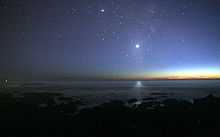Solar System/Venus
Venus, named after the Roman goddess of love, is often known as the Morning Star or Evening Star. This is because it reaches its brightest just before sunrise or soon after sunset. It is the second closest planet to the Sun, after Mercury. Venus has no moons. Its diameter of 12,104 kilometers (7,521 mi) is 0.95 times that of Earth; Venus is the sixth largest planet and the second largest of the four terrestrial planets. If you were standing on Venus, you would weigh 90% of what you weigh on Earth.

Orbit
editVenus orbits the Sun once every 224.70 Earth-days in the most nearly circular orbit of any planet. Its average distance from the Sun is 0.723 astronomical units (108,200,000 km; 67,200,000 mi) (astronomical units, meaning Earth-Sun distances).
Rotation
editThe rotational characteristics of Venus are interesting and unique. It rotates retrograde (that is, in the opposite direction from its revolution around the Sun), so the Sun rises in the west and sets in the east. The only other planet with retrograde rotation is Uranus, but whereas Uranus is tipped over by almost 90°, Venus has only a very slight tilt — the smallest axial tilt of any planet except Mercury. Venus rotates once relative to the stars every 243.02 Earth-days, a rotational period that is far longer than that of any other planet; its equatorial rotational velocity of 6.52 kilometers (4.05 mi) per hour is far slower than that of any other planet. Because of the combination of an orbital period of 224.70 Earth-days and a retrograde rotational period of 243.02 Earth-days, a solar day (noon to noon) on Venus lasts for about 116.8 Earth-days, and it has about 1.9 solar days per orbital period.
Physical Characteristics
editVenus is a rocky planet, similar in size to the Earth. We have little data on its interior but we think it is likely to be similar to Earth (that is, have a distinct core, mantle and crust). Unlike Earth there is no observable plate movement.
Atmosphere
editVenus has an atmosphere comprised of 96.5% carbon dioxide and 3.5% nitrogen. This high level of CO2 creates a "greenhouse effect". The surface atmospheric pressure is nearly 100 times greater than Earth's, equivalent to being 1 kilometer (0.62 mi) underwater on Earth.
The amount of CO2, and the clouds of sulphur dioxide, create a huge greenhouse effect. Venus is hotter than Mercury despite receiving only one quarter of the energy from the Sun that Mercury does. Typical temperatures are 480 °C (896 °F), despite Venus not being the closest planet to Sun.
Venus once had liquid water until the last 800 million years ago.
The Surface
editMost of Venus's surface is smooth plains, with two areas of highlands. The highest mountain, Maxwell Montes, rises 11 kilometers (6.8 mi) above the surface.